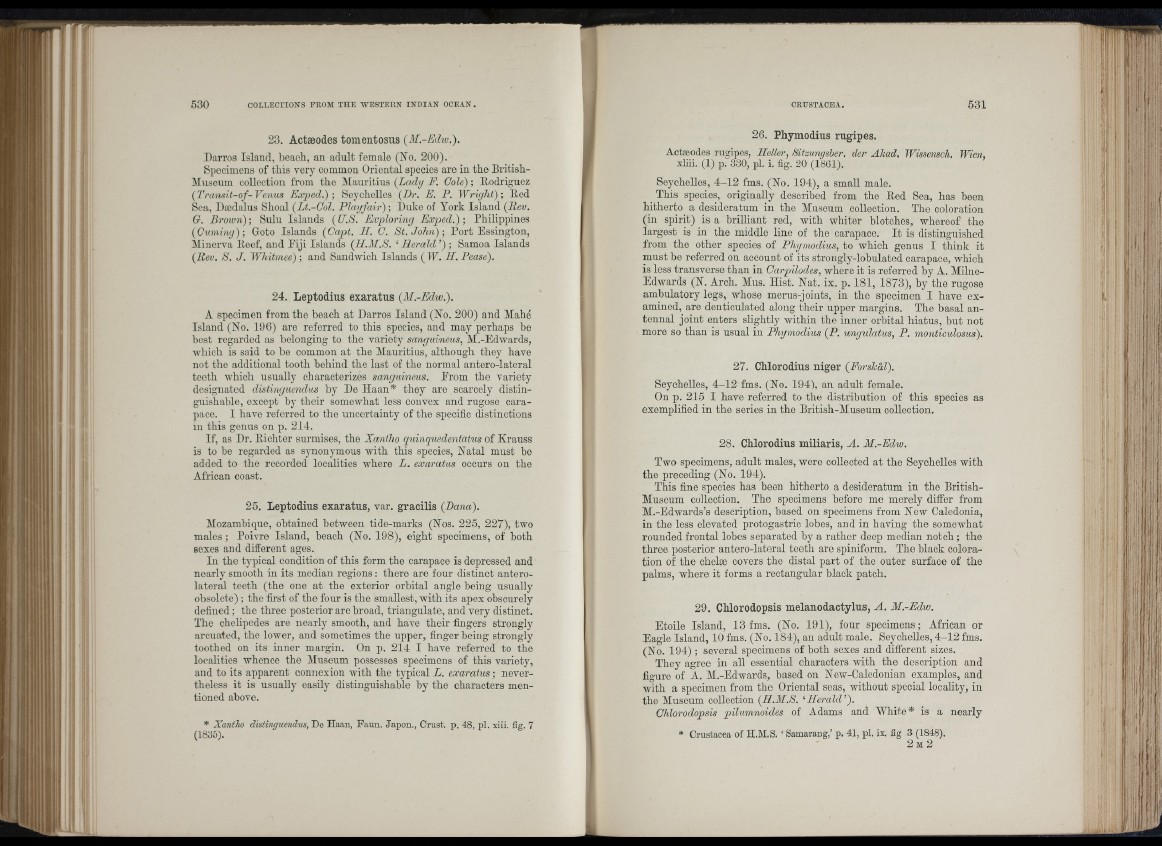
i
■3::! ;i
fü
■íijl
I» 'iii" I
?
i
M
|! ill
l i ’
'lÍ!
23. Actæodes tomentosus (M.-Ediu.).
Darros Island, beach, an adult female (No. 200).
Specimens of this very common Oriental species are in the British-
Museum collection from tbe Mauritius (Lady F. Cole) ; Rodriguez
(Transit-of-Venus Exped.); Seychelles (Dr. E. P. Wright); Red
Sea, Dædalns Shoal (Lt.-Col. Playfair) ; Duke of York Island (Pev.
G. Broivn); Sulu Islands (U.S. Exploring Exped.); Philippines
(Cuming); Goto Islands (Capt. II. 0. S t.Jo h n ); Port Essington,
Alinerva Reef, and Fiji Islands (H.M.S. ‘ Herald ) ; Samoa Islands
(Pev. S. J . Whitmee) ; and Sandwich Islauds ( W. H. Pease).
24. Leptodius exaratus (AI.-Edw.).
A specimen from the beach at Darros Island (No. 200) and Mabe
Island (No. 196) are referred to this species, and may perhaps be
best regarded as belonging to tbe variety sanguineus, Al.-Edwards,
which is said to be common at tbe Alauritius, although they have
not the additional tooth behind tbe last of the normal antero-lateral
teeth wbicb usually characterizes sanguineus. Erom tbe variety
designated distinguendus by De Haan* they are scarcely distinguishable,
except by their somewhat less convex and rugose carapace.
I have referred to tbe uncertainty of the specific distinctions
iu this genus on p. 214.
If, as Dr. Richter surmises, the Xantho quinquedentatus of Krauss
is to be regarded as synonymous witb this species, Natal must be
added to the recorded localities where L . exaratus occurs on tbe
African coast.
25. Leptodius exaratus, var. gracilis (Dana).
Alozamhique, obtained between tide-marks (Nos. 225, 227), two
males ; Poivre Island, beach (No. 198), eight specimens, of both
sexes and different ages.
In tbe typical condition of this form tbe carapace is depressed and
nearly smooth in its median regions : there are four distinct anterolateral
teeth (the one at the exterior orbital angle being usually
obsolete) ; the first of the four is tbe smallest, witb its apex obscurely
defined; the three posterior are broad, triangulate, and very distinct.
Tbe chelipedes are nearly smooth, and have tbeir fingers strongly
arcuated, tbe lower, and sometimes the upper, finger being strongly
toothed on its inner margin. On p. 214 I have referred to tbe
localities whence the Aluseum possesses specimens of tbis variety,
and to its apparent connexion with tbe typical L. exaratus; nevertheless
it is usually easily distinguishable by tbe characters mentioned
above.
* Xantho distinguendus, De Haan, Faun. Japon., Orust. p. 48, pi. xiii. iig. 7
(1835).
26. Phymodius rugipes.
Actæodes rugipes, Heller, Sitzungsher. der Akad. Wissensch. Wien,
xliii. (1) p. 330, pi. i. fig. 20 (1861).
Seychelles, 4 -12 fms. (No. 194), a small male.
_ Tbis species, originally described from tbe Red Sea, has been
hitherto a desideratum in tbe Aluseum collection. The coloration
(in spirit) is a brilliant red, witb whiter blotches, whereof tbe
largest is in the middle line of the carapace. I t is distinguished
from tbe other species of Phymodius, to wbicb genus I think it
must be referred on account of its strongly-lobulated carapace, wbicb
is less transverse than in Carpilodes, where it is referred by A. Alilne-
Edwards (N. Arch. Mus. Hist. Nat. ix. p. 181, 1873), by the rugose
ambulatory legs, whose merus-joints, in tbe specimen I have examined,
are denticulated along their upper margins. The basal antennal
joint enters slightly within the inner orbital hiatus, but not
more so than is usual in Phymodius (P. ungulatus, P. monticulosus).
u
27. Chlorodius niger (Forskal).
Seychelles, 4 -12 fms. (No. 194). an adult female.
On p. 215 I have referred to tbe distribution of this species as
exemplified in tbe series in the British-Aluseum collection.
28. Chlorodius miliaris, A . M.-Edw.
Two specimens, adult males, were collected at tbe Seychelles witb
tbe preceding (No. 194).
This fine species has been hitherto a desideratum in tbe British-
Museum collection. Tbe specimens before me merely differ from
M.-Edwards’s description, based on specimens from New Caledonia,
in the less elevated protogastric lobes, and in having the somewhat
rounded frontal lobes separated by a ratber deep median notch ; tbe
three posterior antero-lateral teeth are spiniform. Tbe black coloration
of tbe cbelæ covers tbe distal part of tbe outer surface of tbe
palms, where it forms a rectangular black patch.
A,
29. Chlorodopsis melanodactylus, A . M.-Edw.
Etoile Island, 13 fms. (No. 191), four specimens; African or
Eagle Island, 10 fms. (No. 184), an adult male. Seychelles, 4-12 fms,
(No. 194) ; several specimens of botb sexes and different sizes.
They agree in all essential characters witb the description and
figure of A. M.-Edwards, based on New-Caledonian examples, and
witb a specimen from the Oriental seas, without special locality, in
the Museum collection (H.M.S. ‘■Herald’).
Chlorodopsis pilumnoides of Adams and White* is a nearly
* Crustacea of H.M.S. ‘ Samarang,’ p. 41, pi. ix, ng 3 (1848).
2 m 2